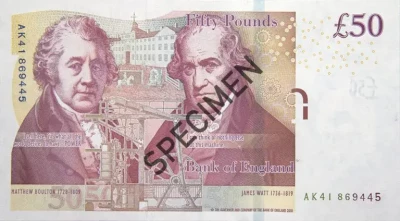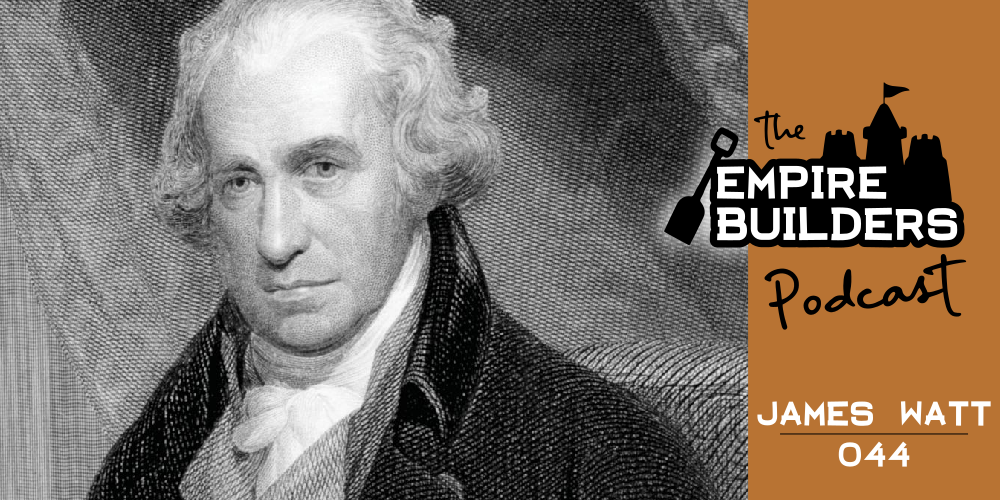Cars are marketed today using the term horsepower. However, the term was created long before cars. Find out why James Watt invented the term.
Subscribe: Apple Podcasts | Google Podcasts | Amazon Music | Blubrry | RSS | More
Dave Young:
Stephen Semple, when you told me that today’s episode was going to be about James Watt, the only James Watt I could think of was the guy, I think he was Secretary of Interior under Reagan, maybe. I mean, it was a long time ago, but I don’t think that’s probably who we’re talking about today. Is it?
Stephen Semple:
No, we’re going back even earlier than that.
Dave Young:
Even farther.
Stephen Semple:
See that light bulb? See that light bulb behind you?
Dave Young:
That, that Watt?
Stephen Semple:
Yeah. Here’s the funny thing about wattage as a way of measuring electrical flow. He actually never coined that term.
Dave Young:
The original James Watt, the man who our 60 watt bulb is named after, never coined the term wattage.
Stephen Semple:
No. It was actually a term that was coined 60 years after his death, and it was proposed by William Siemens of, yes, Siemens Electric.
Dave Young:
Oh, wow.
Stephen Semple:
Yeah. In honor of James Watt saying, I think we should call this wattage. But that happened 60 years after Watts’s death.
Dave Young:
Okay, so it’s a measure of, is it a measure of power?
Stephen Semple:
Yeah, it’s a measure of electricity used. James Watt was, actually what we’ll learn from this, he was far too smart to think that that would be actually a good term. Where Watt was known for actually was not work with electricity, but he did a lot of work with steam power, and he basically created the principles that steam engines work under today.
Dave Young:
Okay.
Stephen Semple:
 He was a really big deal, and here’s how big a deal James Watt is in history. In May of 2009, the Bank of England announced that Watt and his partner Bolton were going to be on the 50-pound note. When you get your picture on a banknote, you’re a big fricking deal.
He was a really big deal, and here’s how big a deal James Watt is in history. In May of 2009, the Bank of England announced that Watt and his partner Bolton were going to be on the 50-pound note. When you get your picture on a banknote, you’re a big fricking deal.
Dave Young:
Oh, yeah.
Stephen Semple:
This podcast is a business podcast, it’s not an inventor podcast, and here’s the reason why we want to study James Watt.
Dave Young:
Okay.
Stephen Semple:
Between the period of 1780 and 1790, he received 76,000 pounds in royalties for his patents. That would be equivalent to around $200 million in today’s dollar.
Dave Young:
That predates the industrial revolution, really.
Stephen Semple:
It is actually at the very front end of the industrial revolution, and that was just on his patents. This wasn’t actually on design work or selling of stuff, this was on the patents that he had put together around steam power.
Dave Young:
Wow, okay. What business was he in?
Stephen Semple:
Well, and this is what we’re going to study. We’re not going to study his inventions, but basically how he sold them and how he popularized them. Because what we know is it takes a lot more than just building something, and they will come. We’ve talked about that in other podcasts. It’s much more than that. This is what we’re going to explore. James was born on January 19, 1736, in Renfrewshire, Scotland, which is in the west lowlands of Scotland. When he was 18, his mother died, and his father was very poor, and he decided, I’m going to travel to London to make my fortune. He traveled to London, and he got training as an instrument maker. Then he returned to Scotland, but set up shop in Glasgow. Glasgow, in that time, was very much at the forefront of the industrial revolution. It was really the place to be.
At first, he worked on maintaining and repairing scientific instruments that were used at the university, and he helped out with demonstrations and all this other stuff. He repaired quadrants and parallel rulers and scales and parts for telescopes and barometers, all sorts of different stuff. Then, in 1759, he formed a partnership with John Craig, who was an architect and a businessman. What they set up a business to do was to make and sell musical instruments and toys. This partnership lasted for basically six years. They built up to about 16 employees. His partner, John Craig died, and really, James wasn’t interested in the business, so he sold the business to one of the partners and moved on to other things.
Now, this is why we’re interested in Watt. Watt became known for the efficiency he created to the steam engine. He didn’t invent the steam engine, he improved dramatically upon it. He eventually teamed up with Matthew Bolton, who owned Soho Manufacturing near Birmingham, to make these machines. These are the two guys that got on to the 50-pound note for doing this work. What Watt did was not only the brilliance in terms of his invention, what Watt did was really brilliant in how he promoted the invention. Because, as we know, getting acceptance of new inventions is not easy. To your point, Dave, this was the big beginning of the industrial revolution. As we know, it’s not like, “Hey, there’s this machine. You should buy it and use it.” Right?
Dave Young:
Yeah, you got to convince somebody a machine’s a good idea.
Stephen Semple:
Yeah, and this initial machine was really large and limited to where it could be. To put in perspective, it was not small enough yet to power a train. That’s how big this stuff was.
Dave Young:
Okay.
Stephen Semple:
It got reduced in size to become a train engine. What he decided to do was target mining.
Dave Young:
Okay.
Stephen Semple:
Again, there was a lot of mining in Scotland, and mines used these large draft horses to raise the minerals and things like that out of the mine. He said you know what? These will be ideal customers for his invention. He did two really smart things, and this is really where the lesson lies with James Watt. The first thing he did was he realized that his machine was going to replace draft horses that were being used in the mines to raise the minerals. What would most people do? Most people would build this comparison chart and all of this stuff. Here’s the benefits of a horse, here’s the benefit of my machine.
Dave Young:
Oh my gosh, I think I-
Stephen Semple:
Educate the customer on the type of machine they would need. Right?
Dave Young:
I think I see where you’re going.
Stephen Semple:
Yeah. He created the term horsepower, and he actually went out and he took a draft horse and he measured how much they could do. He created a way of measuring that, built a unit of measurement around it so it wasn’t BS, and he called it horsepower.
Dave Young:
You could easily converse to these mine owners if it takes five draft horses to pull a load of ore up out of the shaft of the mine, how big of a machine are you going to need?
Stephen Semple:
Yes, he found it was a real comparison. But, now to your point, Dave, think about how easy it is for the customer to now figure out that equation in their head. I used two horses. I need a two-horsepower engine, at a minimum.
Dave Young:
Yeah.
Stephen Semple:
Then not only that, what am I replacing? I’m replacing two horses.
Dave Young:
Brilliant. He made the engine better and then figured out the terminology to make it easily understood to his market.
Stephen Semple:
Yeah. He took the unfamiliar, the steam engine, and attached it to the familiar, horsepower.
Dave Young:
That’s brilliant. I always go back to Apple for some reason. But it’s like when Jobs said a thousand songs in your pocket.
Stephen Semple:
Yes.
Dave Young:
Right? Oh, now I understand what that is.
Stephen Semple:
Yes, and we’ll put a copy of that ad in the show notes, the one that Dave is referring to. Because, at that time, Apple was new to the music industry. It was dominated by Sony and whatnot, and everybody else was making MP3 players.
Dave Young:
Nobody really cared about that. With Watt, you could tell me how big the boiler is, you could tell me how much fuel it uses, you could tell me how hard it is to assemble or operate. But, what you really need to tell me is, no, this will do the work of four horses.
Stephen Semple:
Yes. Same idea, simple.
Dave Young:
The cool thing about James Watt then is, that we’ve gone away from wattage as a measure of the brightness of light bulbs. Right? Now they’re LEDs. They were at fluorescents for a while. But, we still look at the box and we go, oh, this one is the equivalent of a 60-watt bulb because that’s what we remember. We don’t remember lumens. We don’t remember any other measure of brightness than, oh, well, a 60-watt bulb, that’s pretty bright, but it’s not as bright as a hundred-watt bulb. In our mind, we have these comparisons that are all based on wattage because that’s what we grew up with. I wonder if people are going to get away from that, or if that one’s just stuck in the terminology of the day?
Stephen Semple:
It’s now the familiar. Again, what the lesson here is for businesses, especially if you’re creating an innovation, your innovation is new, it’s unfamiliar. Try to find a familiar to attach it to. Horsepower, awesome. Thousand songs in my pocket. I’m taking this unfamiliar, and I’m attaching it to the familiar, making it simple and concrete, and the customer can now go, I get it. I immediately get it. The other thing that Watt did that was really brilliant, is he also tied what he charged mines, he tied it to the savings that the mines had as well. That was the second thing that he did that was really brilliant. We’ve often talked about how, when you attach your fees to a savings or revenue or something along that lines, you can often charge so much more. At the beginning, I said James Watt would never think about wattage for a light bulb, he would try to find a familiar.
Dave Young:
There were candle powers of bulbs.
Stephen Semple:
Yes.
Dave Young:
I don’t think I’ve heard that one in a while, but I think on really, really bright spotlights and things, it’s so many candle power.
Stephen Semple:
Right, so many candle power.
Dave Young:
He’s the guy I’m going to think of when I hear the phrase steampunk.
Stephen Semple:
He was the original steampunk, and he’s on the 50-pound note.
Dave Young:
All right, here’s the James Watt. Thanks for listening to the podcast. Please share us, subscribe on your favorite podcast app, and leave us a big fat juicy five-star rating and review. If you have any questions about this or any other podcast episode, email to questions@theempirebuilderspodcast.com.
- What the 1920s Can Teach Us About the AI Boom - July 9, 2025
- How’d The Bananas Build a Million-Person Waitlist? - July 2, 2025
- Innovation or Iteration? Spin Master’s Paw Patrol Playbook - June 23, 2025

